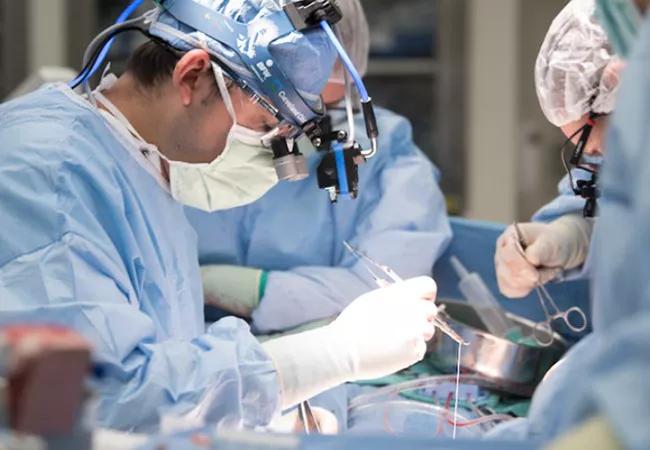Cardiac surgeon Patrick Vargo, MD, reflects on his first year as Cleveland Clinic staff

During his residency in cardiothoracic surgery at Cleveland Clinic, Patrick Vargo, MD, knew he was already where he wanted to spend his career. While training, he developed a specialty interest in aortic operations and had the opportunity to take part in a variety of clinical research projects, serving as first author on publications on obesity and cardiac surgery outcomes, management of aortic aneurysms, and cardiac surgery outcomes in patients with previous solid organ transplantation.
Advertisement
Cleveland Clinic is a non-profit academic medical center. Advertising on our site helps support our mission. We do not endorse non-Cleveland Clinic products or services. Policy
At the completion of his residency in 2019, Dr. Vargo was delighted to be invited to join Cleveland Clinic’s Department of Thoracic and Cardiovascular Surgery. Consult QD recently spoke with him about his first year on staff and his aspirations for the future.
Q: Why did you choose Cleveland Clinic for your residency?
Dr. Vargo: Cleveland Clinic has a very well-established history at the forefront of cardiovascular surgery; a lot of giants in the field have been here. What especially appealed to me is the reputation of being fearless in handling difficult cases, an outlook that is continually pushing the specialty forward.
Q: How did you decide on cardiac surgery as a specialty?
Dr. Vargo: There’s nothing more rewarding than meeting people in life-or-death situations, having the ability to treat them and seeing them doing well afterwards. The results are very tangible. For chronic aortic diseases, we also have the opportunity to see patients multiple times throughout their lifetime and develop long-term relationships. It’s very satisfying.
Q: What sparked your specialty interest in aortic conditions?
Dr. Vargo: The aorta traverses the chest and abdomen, so there are many different problems that can affect it, which offers a variety of opportunities for treatment and possibilities for technique advancement. Efforts to make aortic procedures safer and less invasive are major areas of growth in cardiothoracic surgery; in 2019, Cleveland Clinic performed 1,371 aorta operations, including 1,110 on the thoracic aorta. Thoracic endovascular aortic repair [TEVAR] for thoracic aneurysms and dissections as well as the expansion of transcatheter aortic valve replacement [TAVR] for aortic valve disease are just some of the exciting developments that have emerged in recent years, and Cleveland Clinic has been instrumental in advancing such therapies.
Advertisement
Aortic diseases are also fascinating in that many are increasingly recognized as being a component of genetic disorders, such as Loeys-Dietz syndrome, Marfan syndrome and familial thoracic aortic aneurysm and aortic dissection [familial TAAD], among others. Often a patient with an unusual syndrome is not recognized as having one until presenting for surgical repair of an aneurysm or dissection. We play an important role in identifying such syndromes with cardiologists and medical geneticists so patients can be monitored and treated appropriately, and so that family members can be screened as well.
Q: What are likely to be your next research projects?
Dr. Vargo: Given the volume of patients we see at Cleveland Clinic with a wide range of conditions, analysis of our own outcomes is especially fruitful. I’m particularly interested in the treatment of aortic aneurysms and chronic aortic dissection and their evolution, areas with a multitude of unanswered questions: How do different imaging characteristics predict risk when monitoring a dissection or aneurysm? When do you jump in to treat? Under what conditions is open surgical repair the optimal intervention compared with endovascular strategies? All these questions require good data to answer, and fortunately Cleveland Clinic keeps excellent records in a registry format that’s especially amenable to research.
Q: Your first year on staff has certainly been an exceptional one, given the coronavirus pandemic. What has that been like?
Advertisement
Dr. Vargo: Although I haven’t worked directly with patients critically ill with COVID-19, repercussions of the pandemic have definitely been in the background, adding another layer of stress for our patients. Now that we are again open for nonemergency surgeries, we have to help patients navigate decisions on whether to proceed with an intervention that had been put off during the early months of the pandemic. The prospect of undergoing heart surgery is already anxiety-inducing, even without concerns about the coronavirus. But another part of the equation is the need to optimize cardiac health and not delay necessary treatment before irreversible heart damage develops.
Q: You’ve been on staff at Cleveland Clinic for a year now. What’s your impression?
Dr. Vargo: What continually amazes me is the degree of collegiality, not only within my department but across specialties. People work together and share difficult clinical questions and solutions. Being in this kind of work environment is a true pleasure. It also fosters innovation and is an important reason we can handle such complex cases.
Q: What do you look forward to in the years ahead?
Dr. Vargo: I know that innovation will always be central to this field, and that’s what excites me. I am continuously witnessing the development of new tools and their expanding application to more complex surgeries. I am thrilled to be at this remarkable place where I can participate in that evolution.
Advertisement
Advertisement

End-of-treatment VALOR-HCM analyses reassure on use in women, suggest disease-modifying potential

New Cleveland Clinic data challenge traditional size thresholds for surgical intervention

3 specialists share multidisciplinary perspectives on a widely impactful cardiovascular condition

Experience-based takes on valve-sparing root replacement from two expert surgeons

Two surgeons share insights on weighing considerations across the lifespan

Join us in Florida this winter for a long-standing CME favorite

BITA grafts themselves are rarely to blame, and outcomes can be good

First-in-human phase 1 trial induced loss of function in gene that codes for ANGPTL3